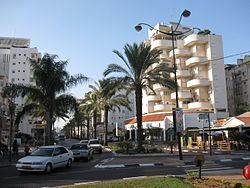Founded 1935 | Area 19.24 km² Local time Monday 7:08 AM | |
 | ||
Weather 14°C, Wind W at 26 km/h, 87% Humidity Points of interest The Four Seasons Park, Park Atidim, Pecan Public Garden, Sportech Hod Hasharon, Tel Qana | ||
Hod HaSharon (Hebrew: הוֹד הַשָּׁרוֹן, lit. "Splendor of the Sharon") is a city in the Central District of Israel. The city is located approximately 10 kilometres (6.2 mi) east of the Mediterranean coastline, south of Kfar Saba, southeast of Raanana, and northeast of Ramat HaSharon.
Contents
- Map of Hod Hasharon Israel
- History
- Magdiel
- Ramatayim
- Hadar
- Ramat Hadar
- Demographics
- Education
- Twin towns Sister cities
- Notable residents
- References
Map of Hod Hasharon, Israel
Hod HaSharon was officially declared a city in 1990 following the merging of four towns: Magdiel, Ramatayim, Hadar, and Ramat Hadar. The official land area of Hod HaSharon is 19.239 square kilometres (7.428 sq mi), and according to the Israel Central Bureau of Statistics (CBS), in 2015 the city had a total population of 56,659.
History
Hod HaSharon was created in 1964 when the settlements of Magdiel, Ramatayim, Hadar, and Ramat Hadar merged. Hod Hasharon was governed by a local council until it was declared a city in 1990.
Magdiel
Magdiel was founded on August 2, 1924. The decision to establish Magdiel was reached at a founders meeting in Tel Aviv in July. A group of 12 settlers of Ashkenazi origin received a plot of land from Yehoshua Hankin which they cultivated and prepared for farming.
Ramatayim
Ramatayim was founded in 1925 by immigrants from Poland. It was founded on the principle of private initiative. Ramatayim was built on two hills connected by a valley, hence the name Ramatayim, literally 'two hills'. Ramatayim is now the center of Hod HaSharon. According to a census conducted in 1931 by the British Mandate authorities, Ramatayim had a population of 180, in 31 houses.
Hadar
Hadar was established in 1927 by Yael Leah Eichhorn, a middle-class immigrant from Eastern Europe, who was joined soon after by a group of Italian Jews. The land was purchased from the Abou Kishk Bedouin tribe. The pioneers decided to build a rural settlement based on citrus crops (hence the village's name, "Hadar" being Hebrew for "citrus"). In its early years, the farmers of Hadar also engaged in poultry farming. According to the 1931 census Hadar had 71 inhabitants, all Jews, in 23 houses.According to the 1931 census Hadar had 71 inhabitants, all Jews. In the early 1940s, Yemenite immigrants moved to Hadar, establishing the Shikun Hateymanim quarter, today part of the Gannei Tzvi neighborhood. In 1951, Ramatayim and Hadar merged to form Hadar Ramatayim.
Ramat Hadar
Ramat Hadar was established in December 1938 by middle-class immigrants from Nazi Germany, members of the Fifth Aliyah. Ramat Hadar was built on a hill between Kfar Hadar, Ramatayim, and the main road from Petah Tikva to Ramatayim. The economy of Ramat Hadar was based on small farms, mainly poultry farming. and citrus orchards. Ramat Hadar even had its own post office that was open between 1959 and 1989.
Demographics
According to the CBS, the ethnic makeup of the city was in 2006 was 99.9% Jewish and other non-Arab, with no significant Arab population. In 2006 77 immigrants from out of Israel settled in Hod HaSharon as their first place of residence in the country, of whom 68.8% were under 18 years of age. 6.8% of the population of the city consists of immigrants to Israel since 1990. By 2025, the city is planned to have 80,000 inhabitants. The population density of Hod HaSharon is the lowest in the Sharon Plain.
According to the CBS, in 2006 there were 21,700 males and 22,800 females. The population of the city was spread out with 33.2% 19 years of age or younger, 13.0% between 20 and 29, 23.2% between 30 and 44, 18.5% from 45 to 59, 3.6% from 60 to 64, and 8.6% 65 years of age or older. The population growth rate in 2006 was 3.3%.
According to the CBS, as of 2005, there were 18,612 salaried workers and 2,006 are self-employed in the city. The mean monthly wage in 2004 for a salaried worker in the city was ILS 9,698, a year-on-year increase of 7.1%. Salaried males had a mean monthly wage of ILS 13,326 (a real change of 9.5%) versus ILS 6,306 for females (a real change of 1.6%). The mean income for the self-employed is ILS 8,490. There are 335 people who receive unemployment benefits and 300 people who receive an income guarantee.
Education
According to the CBS, there are 18 schools and 8,083 students in the city: 11 elementary schools: The Democratic School, HaMagen, Yigal Alon, Lapid, Shilo, Mamlachti Alef, Neve Ne'eman, Rabin, Re'ut and Tali (4,406 students). 4 middle schools: HaRishonim, HaShachar, Atidim and Tzurim (1,628 students). 5 high schools: Hadarim, Alexander Muss Institute for Israel Education, Ramon, Mosensohn and Na'amat (2,049 students). 71.7% of the city's 12th graders were entitled to a matriculation certificate in 2001.
Mossensohn Youth Village accepts both Israelis and overseas students. The Alexander Muss High School in Israel offers a program for American high school students who spend two months to a year in Israel. Each year approximately half of the tenth grade class from the Milken Community High School in Los Angeles, CA, come to Hod Hasharon to study for a semester along with this program.
Twin towns — Sister cities
Hod HaSharon is twinned with:
